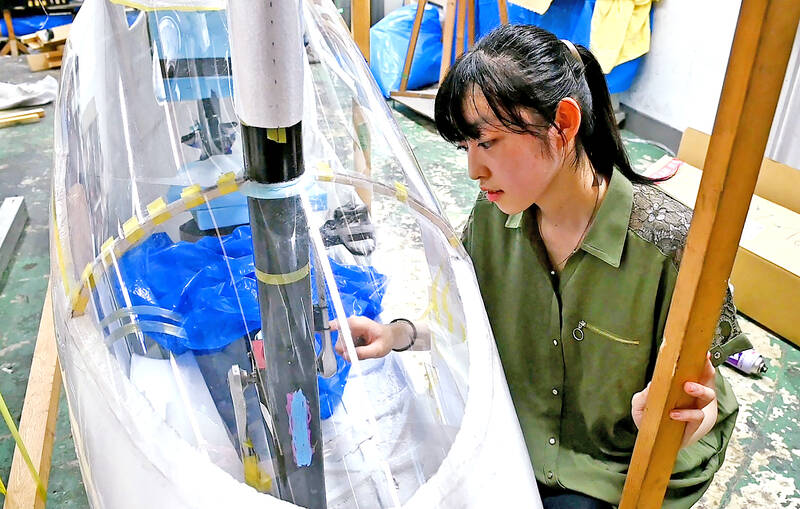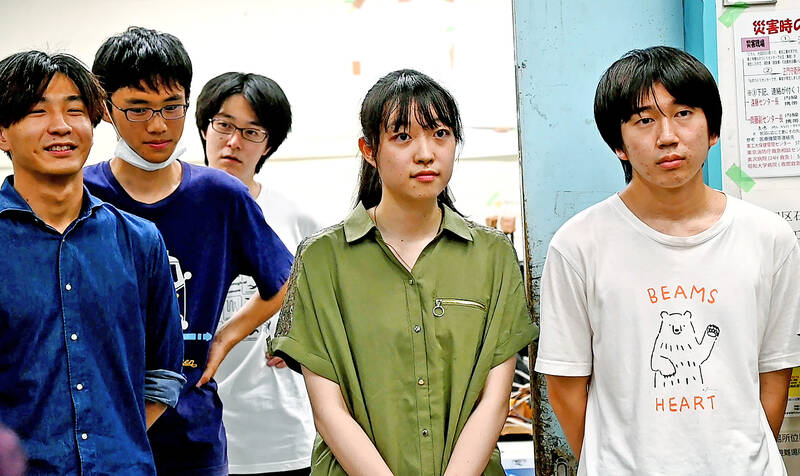A third-year student at one of Japan’s top engineering universities, Yuna Kato has her sights set on a career in research but fears it might be short-lived if she has children.
Kato says relatives have tried to steer her away from science, technology, engineering and mathematics, on the notion that women in the STEM field are too busy at work to juggle dating or families so have a hard time finding husbands.
“My grandmother and mother often tell me that there are non-STEM jobs out there if I want to raise children,” she said.

Photo: Reuters
Kato has made it this far, but many aspiring female engineers choose a different path due to the social stigma, creating a massive headache for Japan. In the IT field alone, the country is looking at a shortfall of 790,000 workers by 2030, largely due to a severe under representation of women.
The upshot, experts warn, is a decline in innovation, productivity and competitiveness for a country that grew into the world’s third-largest economy on those strengths during the last century.
“It’s very wasteful and a loss for the nation,” said Yinuo Li, a Chinese educator with a PhD in molecular biology, whose likeness has been used for a Barbie doll as a female role model in STEM.

Photo: Reuters
“If you don’t have the gender balance, your technology is going to have a significant blind spot and deficiencies,” said the mother-of-three who is in Japan on a cultural exchange program.
UNCONSCIOUS BIAS
Japan ranks last among wealthy nations with only 16 percent of female university students majoring in engineering, manufacturing and construction, and with just one female scientist for every seven. That is despite Japanese girls scoring second-highest in the world in maths and third in science, according to the OECD.
For overall gender parity, Japan’s ranking fell this year to a record low.
The country is on a mission to close the gap.
For the academic year starting in 2024, about a dozen universities — including Kato’s Tokyo Institute of Technology — will heed the government’s call to introduce a quota for female STEM students, joining several others that started this year.
It’s a major reversal for a country where an investigation in 2018 found a Tokyo medical school had deliberately lowered women’s entrance test scores to favor admitting men. School officials felt women were more likely to quit working after having children and would waste their education.
Aiming to change attitudes, the government a few months ago created a 9-1/2-minute video to show educators and other adult show “unconscious bias” deters girls from pursuing STEM studies.
In one scenario, an actor playing a school teacher compliments a student for “being good at math, even though you’re a girl,” making her feel it was abnormal to be a female math whiz. In another, a mother discourages her daughter from pursuing engineering since “the field is male-dominated.”
Working with the private sector, the government’s Gender Equality Bureau will hold more than 100 STEM workshops and events mainly targeting female students this summer — such as learning from Mazda’s sports car engineers.
NO DIVERSITY, NO INNOVATION
More schools and companies including Mitsubishi Heavy Industries and Toyota are offering scholarships to female STEM students to attract talent.
“The scarcity of female engineers is absolutely unnatural then you consider that women account for half of society,” said Mitsubishi Heavy human resources official Minoru Taniura.
“If the make-up of engineers is not the same as the population, we’d fall behind in being able to offer what customers are looking for.”
Panasonic, too, sees benefits from a female perspective, saying its senior engineer Kyoko Ida could relate to women surveyed for the development of the company’s bread machine, whose users were mostly female.
Jun-ichi Imura, the deputy head of Kato’s school, said the lack of diversity has already taken its toll.
“Diversity is the source of innovation, and when we think about whether we’ve seen true innovation in the last few decades at our school or in Japan, it doesn’t look good,” he said.
“Looking ahead to 2050, we all need to think about what needs to be done now.”

On April 26, The Lancet published a letter from two doctors at Taichung-based China Medical University Hospital (CMUH) warning that “Taiwan’s Health Care System is on the Brink of Collapse.” The authors said that “Years of policy inaction and mismanagement of resources have led to the National Health Insurance system operating under unsustainable conditions.” The pushback was immediate. Errors in the paper were quickly identified and publicized, to discredit the authors (the hospital apologized). CNA reported that CMUH said the letter described Taiwan in 2021 as having 62 nurses per 10,000 people, when the correct number was 78 nurses per 10,000

As we live longer, our risk of cognitive impairment is increasing. How can we delay the onset of symptoms? Do we have to give up every indulgence or can small changes make a difference? We asked neurologists for tips on how to keep our brains healthy for life. TAKE CARE OF YOUR HEALTH “All of the sensible things that apply to bodily health apply to brain health,” says Suzanne O’Sullivan, a consultant in neurology at the National Hospital for Neurology and Neurosurgery in London, and the author of The Age of Diagnosis. “When you’re 20, you can get away with absolute

When the South Vietnamese capital of Saigon fell to the North Vietnamese forces 50 years ago this week, it prompted a mass exodus of some 2 million people — hundreds of thousands fleeing perilously on small boats across open water to escape the communist regime. Many ultimately settled in Southern California’s Orange County in an area now known as “Little Saigon,” not far from Marine Corps Base Camp Pendleton, where the first refugees were airlifted upon reaching the US. The diaspora now also has significant populations in Virginia, Texas and Washington state, as well as in countries including France and Australia.

May 5 to May 11 What started out as friction between Taiwanese students at Taichung First High School and a Japanese head cook escalated dramatically over the first two weeks of May 1927. It began on April 30 when the cook’s wife knew that lotus starch used in that night’s dinner had rat feces in it, but failed to inform staff until the meal was already prepared. The students believed that her silence was intentional, and filed a complaint. The school’s Japanese administrators sided with the cook’s family, dismissing the students as troublemakers and clamping down on their freedoms — with